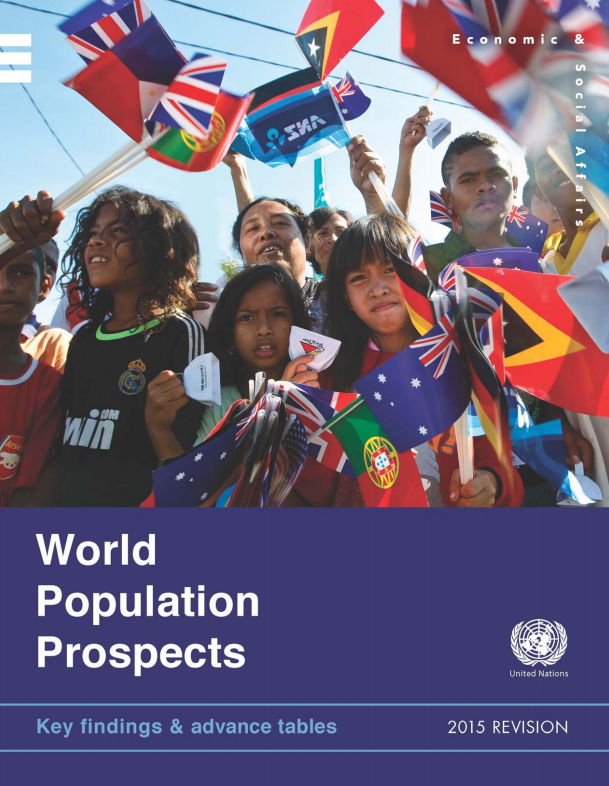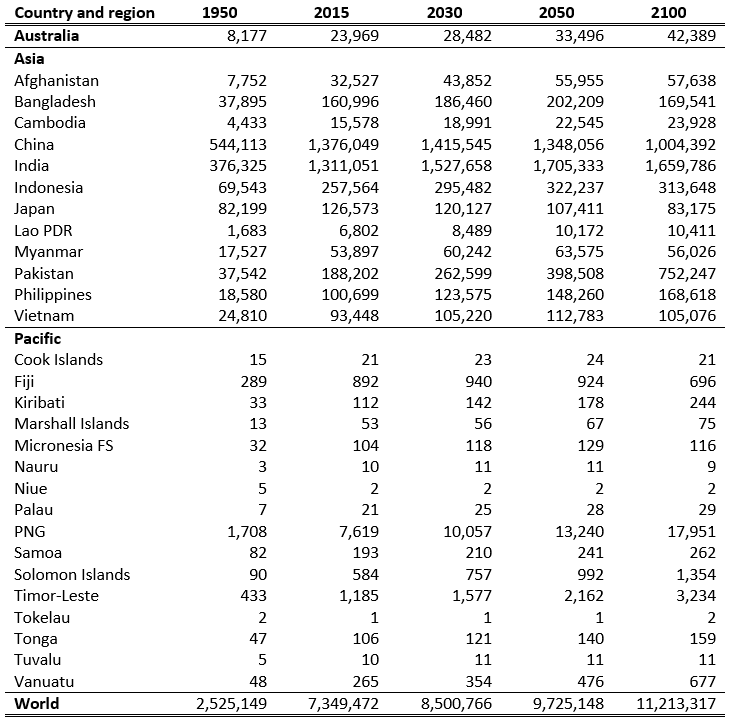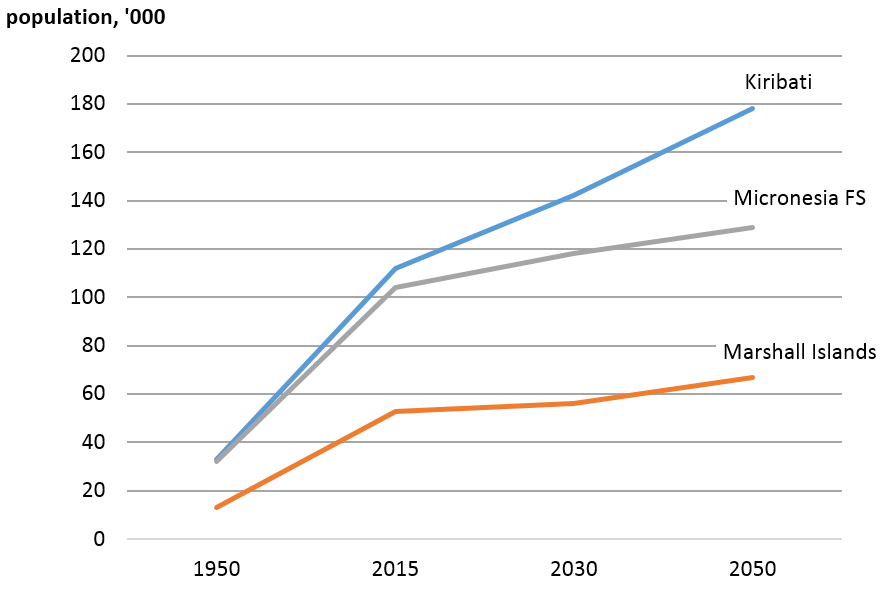The UN has recently released revised projections for global population growth. Almost every page of their report, available here [pdf], has implications for international development. The following provides some of the key findings.
Global trends: more than half of global population growth between now and 2050 is expected to occur in Africa, including least developed countries
World population reached 7.3 billion in July 2015, 2 billion more than 1990, the baseline year for the Millennium Development Goals (MDGs). A further 83 million are projected to be added to the world’s population next year. Most of these will be born in low and middle income countries.
More than half of global population growth between now and 2050 is expected to occur in Africa, even if there is a substantial reduction of fertility levels in the near future. 19 of the 21 high fertility countries (average of five or more children per woman over her lifetime) are in Africa. Africa is projected to add 1.3 billion people to the global population between 2015 and 2050. Asia is projected to be the second largest regional contributor, adding 0.9 billion over the same period. The population in the existing 48 Least Developed Countries, many of which are in Africa, is projected to increase by 39 per cent by 2030 and to double from 954 million in 2015 to 1.9 billion by mid-century. Between 2015 and 2050, the populations of 28 African countries are projected to more than double.
Nine countries are expected to account for more than half of the world’s projected population increase over the period 2015–2050: India, Nigeria, Pakistan, Democratic Republic of Congo, Ethiopia, Tanzania, USA, Indonesia, and Uganda (listed according to the size of their contribution to global population growth). Five of those countries are in Africa, three are in Asia (India, Pakistan and Indonesia). Only one country – the USA – is an OECD country.
Individual countries in Asia and the Pacific
The table below captures the projections for population growth from the report in key countries of Asia and the Pacific.
Population projections (‘000 population)
For Asia, the report states that within seven years the population of India is expected to surpass that of China. By 2022 both countries are expected to have approximately 1.4 billion people. Thereafter, India’s population is projected to continue growing for several decades to 1.5 billion in 2030 and 1.7 billion in 2050, while the population of China is expected to remain fairly constant until the 2030s, after which it is expected to slightly decrease. The largest low-fertility (women having fewer than 2.1 children on average) countries in the world include China, Japan and Vietnam from Asia.
Unlike many similar reports, this report has projections for Pacific island countries, including many of the smaller and micro-states. One noticeable feature is the rapid population growth in certain Pacific island countries, especially in Melanesia. Vanuatu’s population is projected to increase by 33 per cent from 265,000 now to 354,000 by 2030; PNG’s population is projected to increase 31 per cent from 7.6 million to just over 10 million, and Solomon Islands’ population is projected to increase 29 per cent from 584,000 to 757,000. Also noticeable is the rapid increase in population historically of some smaller Pacific island countries, as shown in the graph below.
Population projections for small island states
Population ageing: especially in Asia
The report estimates that the number of people aged 60 or over will more than double by 2050 and more than triple by 2100, increasing from 901 million in 2015 to 2.1 billion in 2050 and 3.2 billion in 2100. 66 per cent of the increase between 2015 and 2050 will occur in Asia, 13 per cent in Africa. The number of persons aged 80 or over is projected to more than triple by 2050 and to increase more than seven-fold by 2100. Globally, the number of persons aged 80 or over is projected to increase from 125 million in 2015 to 434 million in 2050 and 944 million in 2100.
The report notes that ageing of the population has significant implications for the number of potential workers that can then provide tax revenues to support pensions, etc. By 2050, there will be almost complete global parity between the number of older persons aged 60 and above, and the number of children under the age of 15. Currently, African countries have on average 12.9 people aged 20 to 64 for every person aged 65 or above (the ‘Potential Support Ratio’, or PSR), while Asian countries have PSRs of 8.0. Japan, at 2.1, has the lowest PSR. The report notes that:
By 2050, seven Asian countries, 24 European countries, and four countries of Latin America and the Caribbean are expected to have PSRs below 2, underscoring the fiscal and political pressures that the health care systems as well as the old-age and social protection systems of many countries are likely to face in the not-too-distant future.
The overall conclusion is clear. Even though these are estimates and projections, population growth will continue to have major implications for international development. There are opportunities and risks. Those countries that invest in the human capital of their growing populations, pursue good economic policies, and have the enabling environment to create meaningful and productive jobs are likely to benefit from a demographic dividend. Those countries that fail to invest in human capital or pursue inappropriate economic policies are likely to face the challenge of large numbers of unemployed and, subsequently, large cohorts of the aged poor. Changes in the size and structure of populations for the coming decades have largely been set. But countries can still choose good policies or bad.
Ian Anderson is a Research Associate at the Development Policy Centre. He has over 20 years international development experience with AusAID, the World Bank and the Asian Development Bank.








Good thing UNFPA Pacific has been trying to persuade countries to take population growth (and associated issues, especially SRH) seriously. Population policies developed in Vanuatu and Tuvalu recently and currently working on Samoa (as I speak – first policy workshop happening in the Ministry of Finance Planning Div on Tuesday this week) and Solomons. We started n Fiji last year but then the elections came along and some how they’ve lost interest/dropped the ball, not sure which or whether it’s because UNFPA hasn’t been pushing this along with the government.
Jenny
You posted an interesting query about the projected fall in total population of Fiji between 2050 and 2100. I contacted senior officials at the United Nations Population Division in New York and authors of the original report. They responded that the outcome is mainly the effect of the projected fertility decline over a long period of time. They also note that there are, of course, a range of possibilities in those projections. Further details of that range is available here.
Ian
I can find no discussion in the text on why it is assumed that the population of Fiji is going to fall by close to 300,000 people between 2050 and 2100. please explain – I imagine it is a typo? (I shall look at your breakdowns on birth rates etc but think this figure is unlikely
Thanks Jenny.You raise a good point. Page 19 of the UN Report does actually project a decline in the population of Fiji from 924,000 in 2050 to 696,000 in 2100 as cited in the blog (ie it is not a typo). But there is no explanation given in the report for that fall. I have gone back to the original authors of the report asking for a clarification / explanation and will post this as soon as I hear back from them. Thanks again for raising this issue. Ian
The other set of policies countries can pursue are those that ensure contraception is easily available to all women who wish to use it: and, generally, more women wish to use contraception than can get it. There is a blog in this. But for now, there are some useful cost-benefit analyses in Kiribati [pdf], and Solomon Islands and Vanuatu [pdf]. These show what can be saved in health and education costs by investing in contraception, as well as the health benefits for women and their children.
Thanks Jo. Agree entirely. Table S9 (pages 38-42) of the original UN report also provides estimates of Total Fertility Rates for all countries, starting in 1975-1980 and going through to 2095-2100. For the countries you mention, the report estimates that total fertility (average number of children per woman) in Kiribati goes from 5.1 in 1975-80 down to 2.05 in 2095-2100.The corresponding figures for Solomon Islands is 7.04 down to 1.94 and from 5.75 down to 1.90 for Vanuatu. Table S10 on page 43 of the report also ranks the ten countries in the world with the highest total fertility for various time periods. The table is dominated in all time periods by African countries, but with two interesting exceptions. First, Timor Leste, with an average of 5.91 children per woman is ranked as having the ninth highest fertility in the world in the current period 2010-2015. (Niger, with an average 7.63 children is ranked as having the highest fertility in the world in this period). The second interesting exception to the dominance of Africa is that the State of Palestine, with an average 7.5 children per woman had the tenth highest rate of fertility in the world during the period 1975 -1980. In every other case, in every other time period, countries in Africa are in the top ten countries in the world for the highest levels of total fertility. Ian